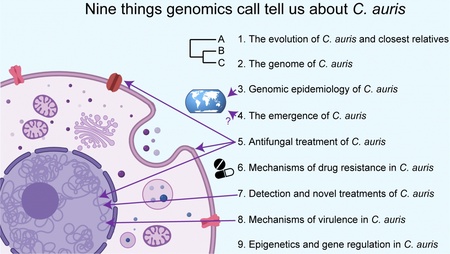Nine Things Genomes Can Tell Us About Candida Auris
Fungal diseases cause more than 1.5 million deaths every year, which exceeds the global mortality for malaria. A limited number of available antifungal drugs is the mainstay of antifungal therapy. For many years, scientists have cautioned that overuse of antibiotics reduces the effectiveness of treatment by promoting the survival of drug resistant bacteria. However, antimicrobial resistance is not only observed in bacteria. Fungi can evolve to become drug resistant, too.
In 2013, Centers for Disease Control and Prevention (CDC) published a report about antibiotic resistance threats, in which they warned about life-threatening and difficult to treat infections caused by Candida fungi. A few years later, an emerging pathogen called Candida auris was added to the CDC “urgent threats” list. C. auris (a species of fungus that grows as yeast) can survive more than a month on surfaces and spreads rapidly in healthcare settings. It can become resistant to all known classes of antifungals and lowered susceptibility of this species to at least one antifungal is a norm, not an exception. In addition, C. auris does not possess distinguishing phenotypic features and therefore is often misidentified as one of rare but far less drug resistant Candida species.
In our recent review article we present nine major lines of enquiry into C. auris that big-data technologies and analytical approaches are beginning to answer. We describe the evolution of C. auris and its closest relatives, present the current view on genomic epidemiology of this species and explain how the recent genomic and transcriptomic work revealed gene and chromosomal features that allowed C. auris to grow at high temperatures and conferred drug-resistance. We reveal mechanisms of virulence and gene regulation that make this organism a successful pathogen and propose several new drugs that could help to save lives of patients infected with a strain of C. auris that is resistant to all known antifungals.
Although genomics studies have provided much information about the biology of this versatile organism, there are still many mysteries related to its ecological niche, evolution and fitness waiting to be unravelled.
You can view the full article here.
Research by Aleksandra Chybowska


